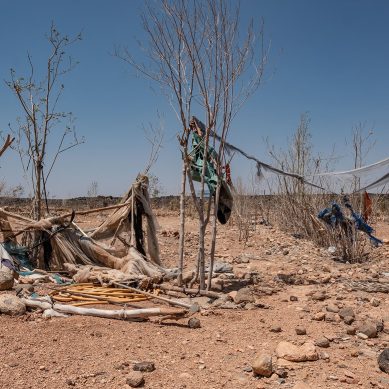
Geothermal Development Company (GDC) has struck viable steam at the Silali field, which is expected to discharge steam at 22 megawatts, marking a major milestone in opening up a new frontier of renewable energy for the country.
The n wind raises Kenya’s profile as a world leader in geothermal energy production. The East African country is estimated to have 10,000 megawatts potential, but has harnessed a paltry 950 s.
Silali is part of three fields that include Korosi and Paka that are a part of the Baringo-Silali-Paka Geothermal project, where GDC has been drilling wells for the past seven years in the geothermal-rich region.
GDC Managing Director and Chief Executive Officer Paul Ngugi said that the first phase of the Baringo-Silali-Paka project targets to develop 300 megawatts spread in three geothermal areas of Korosi, Paka and Silali with each of the fields producing 100 megawatts of power.
He said the success at the Silali field was a major breakthrough in the state corporation’s quest to provide Kenya with affordable and reliable energy, adding that the first viable well at the Baringo-Silali-Paka Geothermal project was struck at the Paka field in 2020.
“The viability of Silali geothermal field will usher Kenya into an age of vibrant geothermal energy,” the MD assured.
While admitting that Silali field was a very productive area, the MD argued that by having one well discharging steam at 22 megawatts was equivalent to drilling about four wells that discharge at 5 megawatts. He explained that the GDC company would make huge saving considering that drilling a well costs Ksh700 million ($5.4 million).
Interviewed, Ngugi expressed GDC’s commitment to ensuring timely delivery of renewable energy projects that will greatly support the country’s development vision and plans. The director said that at Paka field, where most of the work had been done, was slated to start production of the first 100 megawatts by 2028.
He explained that they had drilled for the steam and next was power plant construction adding that they were doing a feasibility study and thereafter scout for investors. He assured that the project would be in place in the next three years feeding power on the national grid.
Noting that all major economies thrive because of access to abundant energy, the MD was happy that geothermal would power Kenya to a vibrant future of great industrial and social development.
At Baringo-Silali-Paka, Ngugi disclosed that GDC had harnessed 75 megawatts of geothermal steam and that the company was targeting to have a 105 megawatts power plant at Paka by 2027. Similarly, GDC had started to open the Suswa field in Naivasha, Ngugi added.
He said power producers will be competitively selected to build power plants at the Baringo-Silali-Paka geothermal fields, which are then expected to start electricity production by 2028. This is as Kenya eyes increased electricity production from geothermal to reduce reliance on hydropower that is prone to weather shocks as well as replace costly thermal power plants.
The Baringo-Silali fields, which are outside the traditional geothermal fields of Olkaria, have capacity to produce an estimated 3,000 megawatts making them an appealing alternative for the country that now needs to balance between making available power to the grid and making it affordable.
While geothermal resources in Kenya are estimated to have a potential to produce 10,000 megawatts, the country has exploited about 950 megawatts so far. Of this, about 800 megawatts is generated at power plants built by Kenya Electricity Generating Company (KenGen) while the balance is by Independent Power Producers (IPPs) Orpower that produces 150 megawatts at its plants at Olkaria and the recently launched 35 megawatts plant by Sosian Energy at Menengai Geothermal Project.
At Baringo-Silali-Paka, GDC has drilled wells that can generate up to 70 megawatts which it intends to increase to 100 megawatts by end of the year.
Ngugi indicated that the IPPs that would put up power plants at the Baringo-Silali fields would sell electricity to Kenya Power at between Ksh8 and Ksh10 (six and seven US dollar cents) per unit. This is the cost for the power producers. This is before taxes, levies and costs such as fuel and forex adjustments are loaded on the power bill.
GDC has been de-risking the fields by way of exploring and drilling wells in areas that show high potential. It did the same in Menengai and parts of Olkaria.
Since it was established about 15 years ago, GDC by bearing the high capital investment for exploring and drilling wells and then inviting other firms to put plants has accelerated geothermal development.
Power generation through geothermal stood at around 200 megawatts in 1998 when GDC was formed. At the moment, about 950 megawatts geothermal installed capacity is generated using steam from GDC wells.
Ngugi indicated that GDC was also exploring wellhead technology at both Menengai and Baringo-Silali-Paka projects, which allows for smaller, modular power plants to be built directly at the wellhead, enabling faster deployment and access to revenues earlier in the investment cycle.
Ideally, wellheads take the shape of a normal geothermal power plant, but in a smaller version. While a geothermal power plant is run by steam piped from tens of wells, a wellhead utilises steam from just a single well. Once the main plant is fully constructed, the MD explained that the wellheads are removed and moved to different stations so that steam from the wells can then feed into the main plant.
The wellhead concept, the MD explained, enables the company to generate more power from each individual well, helps reduce well redundancies and prevents well failures as it involves tapping steam from wells that are undergoing tests or awaiting connection to permanent plants.
“This technology not only helps to utilise the investment put into drilling the wells, which would otherwise be lying idle but also yields benefits through early power generation,” noted the MD.
He also said they were seeking flexible ways of generating electricity by exploring ways of encouraging investments in modular and mobile power plants. The MD explained that geothermal well head units were quick to install and allowed tapping of geothermal wells almost immediately after drilling, compared with the four to five years it takes to construct a conventional power plant.
Ngugi observed that when a geothermal well remains idle, it takes a long time to recover the huge cost, notwithstanding the fact that the money is borrowed at a huge interest rate.
According to the CEO GDC plans to add 1065 megawatts more to the national grid in the next 10 years that will be generated from Menengai (465megwatts), Baringo-Silale (300 megawatts) and 300 megawatts from the South Rift region as the government seeks more geothermal energy.
He noted that the Power plants being developed at Menengai and Baringo-Silali Paka geothermal projects will significantly boost Geothermal Development Company’s revenues. In addition, he said the state corporation still had its sights on achieving financial sustainability by 2029.
“GDC will be able to pay its bills and have some spare money for investments,” he noted.
Currently GDC relies heavily on government funding for its operations. At the Menengai Geothermal Project in Nakuru the first geothermal power plant built by local firm Sosian Energy started electricity production in 2023 after completion through Ksh6.5 billion funding from the China-based Zhejiang Kaishan Compressor.
After de-risking the fields GDC competitively selected three firms, including Sosian Energy alongside, Quantum Power East Africa and the American firm, OrPowerTwenty Two Company, in 2013 through competitive bidding to build, operate and own the first three power plants in Menengai, each generating 35 megawatts to pump into the national grid a cumulative 105 megawatts.
Ngugi disclosed that the construction of Quantum Power East Africa’s power generation facility was 60 per cent complete, while works at Orpower 22 Power Company were 50 per cent complete.
He said the entry of the three Independent Power Producers (IPPs) into electricity generation is expected to yield a significant drop in power tariffs and in turn attract more investors locally and regionally as they will have a huge saving on energy and in turn create more employment opportunities. Prices of various value-added commodities he observed will drop drastically.
Ngugi explained that the state corporation has drilled steam wells at the Menengai Geothermal Project with an output of 165 megawatts, which is more than enough for the first 105 megawatts of electricity expected to be generated by the three IPPs.
Further, GDC has constructed the steam gathering system, while Kenya Electricity Transmission Company (Ketraco) has set up a 132 kilovolt (kV) substation that will transmit electricity from the three power plants.
Under the arrangement referred to as the Menengai Model, GDC was to take care of upfront risks and then invite private sector players to construct, own and operate the plants for 25 years.
According to the MD the completion of the 105 megawatts Menengai project will elevate Kenya’s global ranking to fifth overall, establishing beyond all contestation that economic growth and clean energy development can go hand in hand.
In addition, the renewable energy generation capacity in the country, the Menengai Geothermal Project is expected to reduce greenhouse gas emissions by 1.95 million tonnes of carbon dioxide annually.
- A Tell Media / KNA report / By Esther Mwangi and Dennis Rasto
Geothermal Development Company (GDC) engineers open up steam wells at the Menengai Geothermal Project in Nakuru. (Photo by Dennis Rasto).







